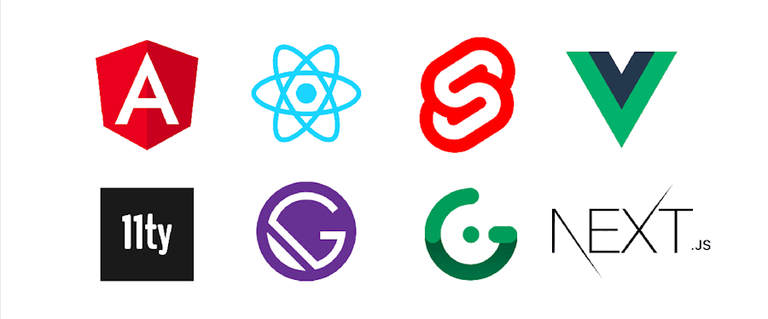The new era tech - JAMstack
The need for speed, security and lower price for development are why the new, modern way of building websites is now thriving - the JAMstack

Static websites are coming back, guys. It’s happening as a reaction to slow, overburdened with options PHP-frameworks, that can be found all over the world wide web. The need for speed, security, and lower price for development are why the new, modern way of building websites is now thriving - the JAMstack. This specific architecture allows developers to experiment with the newest frontend technologies, without being tied to any particular frameworks or instruments. But we will get to that. First, let’s determine what is JAMstack exactly.
What is JAMstack?
JAMstack describes the way of creating static websites without any database. When we use the word ‘static’, we by no means imply simplicity or less interactivity. Following on from the abbreviation comprising the term (“JAM”), we understand that in order to create a static website that would not disgrace the dynamic one, we need only three components:
- JavaScript (“J”): for making the website interactive;
- API (“A”): the source of information, used by the website:
- Markup (“M”): content generator, allowing to create a page layout.
How does it work? Traditional vs JAMstack
To add some more clarity let’s take a look at how the traditional server websites work compared to the JAMstack websites (schematically).
Traditional Server Websites
![]() Traditional websites rendering pipeline
Traditional websites rendering pipeline
A user requests a page. Hosting processes the request and starts a chain of operations (sometimes a very long one) between the database, server, etc. Only after it’s done, the user gets HTML-page in response. All the website updates are uploaded to the server through FTP. The database needs to be maintained separately while being an inherent part of the website. In order to update the content, you need to use a CMS.
JAM Stack websites
![]() JAMStack websites rendering pipeline
JAMStack websites rendering pipeline
A user requests a page. The HTML-file is ready, the response is instantaneous.
All the website updates are uploaded to the Git. After that, the website is automatically getting rebuild with the help of the static sites generator or through the self-configured rebuild system. In order to update the content, you need to use Git or Headless CMS.
Traditional CMS: what are the issues?
For the longest time using some kind of coupled CMS was considered a norm. As time went by, more and more developers were facing difficulties using them, as they were just offering too much to handle. As the necessity for fast loading and simple maintenance of the website grows, the traditional CMSs go out of fashion, as:
They are vulnerable to hacker attacks.
When the influx of visitors happens, the server becomes unresponsive.
Usually, slow down the website speed.
Require constant support and moderation.
We cannot say that the above-stated issues are not fixable. But again, in order to minimize their impact, you will have to hire an experienced web developer which will cost you a pretty penny. Also, imagine that: your website is hacked, or it goes down, or the loading is too slow - additional money lost.
So, how JAMstack fixes these issues?
Hacker attacks
All the wrongdoers can do is copy your HTML files. Well, okay, they are public anyway.
Server
To deploy a static website you do not need a traditional server. You can locate it anywhere you want, from Git Pages to Amazon CDN, or any other services.
Speed
As it has already been mentioned, the page is already built, it’s not being created in runtime. When requested, the user gets a simple HTML file, already filled with content. There are also additional features allowing to cut back on the page weight.
Support
No support, moderation, and backups needed. Everything is stored in Github/Bitbucket/GitLab, or in an archive on your hard drive.
More benefits?...
We are sure you have already concluded some of the most obvious benefits, such as speed or security, but let us provide a few other ones.
SEO
A static development comes with multiple benefits for your search engine optimization, some of which are not widely spoken enough. First of all, the simplification of the URL-addresses and the website’s architecture is much more easily done with JAMstack, than with dynamic site and coupled CMS. Instead of relying on long and complicated URLs from the server’s side, your URLs can be however you want them to.
The potential for the unwanted doubling is also narrowed down. Many CMS automatically generate pages for categories, tags, archives based on the date - the ones that you don’t even need. On the opposite side, static website generators allow being in charge of pages creation and systematization of your content.
Also, there is a number of potential SEO benefits for the websites, that actively use client-side rendering, as well as JavaScript frames. Taking into consideration the fact that your source code is static, the maintenance process of your HTML code candidate versions becomes much easier.
Incredible community
The overall JAMstack community is incredibly united and active. People share a common desire to collaborate and encourage adoption, as well as to help you if you run into challenges. Also, since JAMstack is ideal for deploying documentation, most frameworks have truly exemplary literature.
At last, how are static websites boosting your business?
![]() JAMStack speed benefits diagramm
JAMStack speed benefits diagramm
![]() JAMStack security benefits diagramm
JAMStack security benefits diagramm
If you are doubting whether to build your business website using JAMstack, check these simple arguments drawn from the technology’s benefits mentioned in the article.
Decided that a JAMstack website is for you? Well, send us a word and we will discuss everything you need to know.



